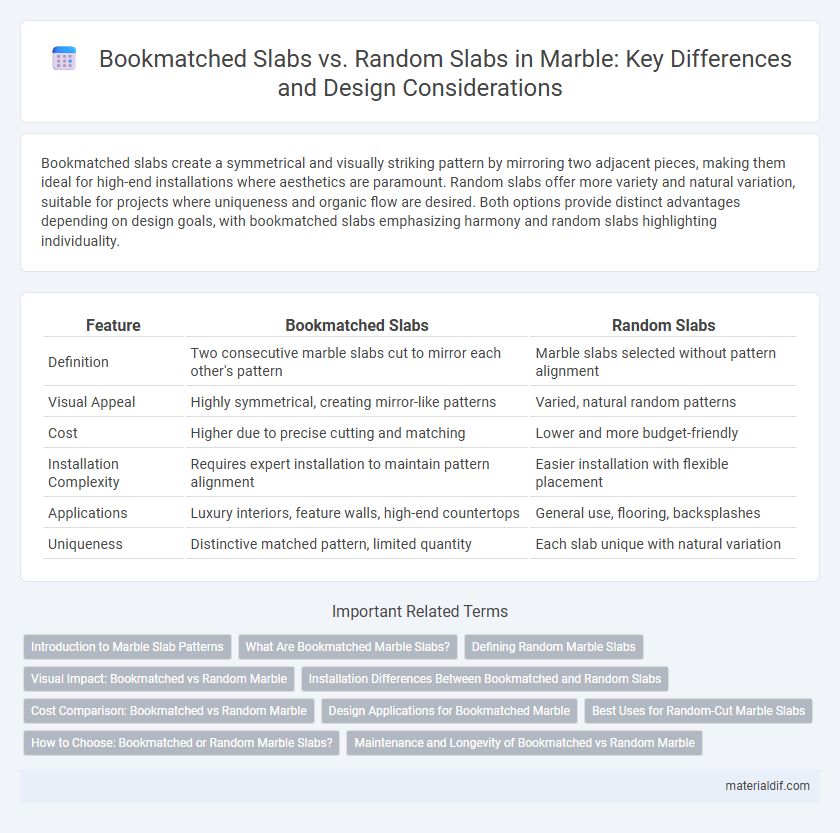Bookmatched slabs create a symmetrical and visually striking pattern by mirroring two adjacent pieces, making them ideal for high-end installations where aesthetics are paramount. Random slabs offer more variety and natural variation, suitable for projects where uniqueness and organic flow are desired. Both options provide distinct advantages depending on design goals, with bookmatched slabs emphasizing harmony and random slabs highlighting individuality.
Table of Comparison
| Feature | Bookmatched Slabs | Random Slabs |
|---|---|---|
| Definition | Two consecutive marble slabs cut to mirror each other's pattern | Marble slabs selected without pattern alignment |
| Visual Appeal | Highly symmetrical, creating mirror-like patterns | Varied, natural random patterns |
| Cost | Higher due to precise cutting and matching | Lower and more budget-friendly |
| Installation Complexity | Requires expert installation to maintain pattern alignment | Easier installation with flexible placement |
| Applications | Luxury interiors, feature walls, high-end countertops | General use, flooring, backsplashes |
| Uniqueness | Distinctive matched pattern, limited quantity | Each slab unique with natural variation |
Introduction to Marble Slab Patterns
Bookmatched slabs create a symmetrical pattern by mirroring two adjacent marble slabs, enhancing visual continuity and elegance in large surfaces. Random slabs feature unique, non-repeating patterns that highlight the natural variation and organic beauty of the marble. Opting for bookmatched slabs ensures a bold, balanced design, while random slabs emphasize individuality and natural texture.
What Are Bookmatched Marble Slabs?
Bookmatched marble slabs are pairs of marble slabs cut from the same block and polished to mirror each other, creating a symmetrical vein pattern when placed side by side. This technique highlights the natural beauty and unique patterns of the marble, enhancing aesthetic appeal in installations like countertops and wall cladding. Bookmatching requires precise cutting and alignment, making it a premium option compared to random slabs that lack coordinated patterns.
Defining Random Marble Slabs
Random marble slabs refer to natural stone pieces cut without aligning their veining patterns, resulting in unique, non-repetitive surfaces. Unlike bookmatched slabs, which mirror each other creating symmetrical patterns, random slabs highlight the stone's organic and varied aesthetics. These slabs are ideal for projects valuing natural diversity and individual character over uniformity.
Visual Impact: Bookmatched vs Random Marble
Bookmatched marble slabs create a striking visual impact by mirroring natural veining patterns, producing symmetrical and harmonious surfaces that elevate the aesthetic appeal of interior spaces. Random marble slabs, with their unique, non-repetitive veining and color variations, offer a more organic and spontaneous look that emphasizes natural beauty and individuality. Choosing bookmatched slabs enhances design precision and luxury, while random slabs highlight distinctiveness and artistic randomness in marble installations.
Installation Differences Between Bookmatched and Random Slabs
Bookmatched slabs require precise alignment during installation to ensure the mirrored patterns seamlessly meet at the seams, demanding skilled craftsmanship and careful planning. Random slabs offer more flexibility in layout, allowing installers to focus on fitting and level adjustments rather than pattern continuity, which generally reduces installation time and complexity. The choice between bookmatched and random slabs directly impacts labor costs and project timelines due to the varying levels of precision required.
Cost Comparison: Bookmatched vs Random Marble
Bookmatched marble slabs generally incur higher costs due to the intricate process of matching and aligning the veining patterns, which demands skilled labor and results in increased waste. Random slabs are more cost-effective as they are cut and installed without regard to pattern alignment, reducing both fabrication time and material loss. Choosing between bookmatched and random marble affects project budgets significantly, with bookmatching typically adding 20-40% more to overall expenses compared to random slab installations.
Design Applications for Bookmatched Marble
Bookmatched marble slabs create symmetrical patterns by pairing consecutive cuts for mirror-image designs, enhancing visual harmony in applications such as feature walls, countertops, and luxury flooring. This precise alignment of veins and textures makes bookmatched marble ideal for statement pieces and high-end architectural elements where uniformity and elegance are crucial. Random slabs offer natural variation but lack the dramatic, balanced aesthetic that bookmatched slabs provide, making the latter preferable for sophisticated and artistic design projects.
Best Uses for Random-Cut Marble Slabs
Random-cut marble slabs offer unique veining patterns and natural variations that make them ideal for large-scale applications requiring continuous flow and organic appearance, such as expansive floorings and feature walls. These slabs provide a more cost-effective option compared to bookmatched slabs, suitable for projects where uniform symmetry is less critical. Their natural, unpaired patterns enhance spaces emphasizing texture and depth without the need for mirrored designs.
How to Choose: Bookmatched or Random Marble Slabs?
Bookmatched marble slabs create a symmetrical, mirror-image pattern ideal for showcasing natural veining and enhancing aesthetic appeal in spaces like countertops and feature walls. Random marble slabs offer unique, non-repetitive patterns that provide a more organic, varied look suited for eclectic or rustic designs. Choose bookmatched slabs for a dramatic visual impact and seamless flow, while random slabs are preferable for a natural, individualized appearance where uniformity is less critical.
Maintenance and Longevity of Bookmatched vs Random Marble
Bookmatched marble slabs exhibit enhanced visual continuity and symmetry, but their maintenance demands careful attention to preserve the intricate veining patterns, ensuring longevity through consistent sealing and gentle cleaning. Random slabs, while easier to maintain due to less emphasis on pattern alignment, may show wear inconsistently over time, potentially reducing aesthetic lifespan without proper care. Both types benefit from professional sealing and routine upkeep, but bookmatched installations require more precise maintenance practices to uphold their premium appearance and durability.
Bookmatched slabs vs Random slabs Infographic

 materialdif.com
materialdif.com